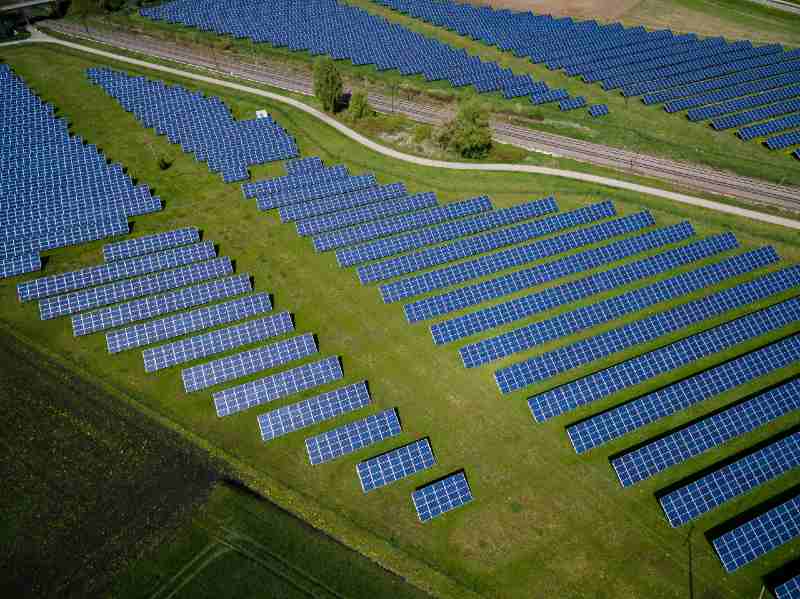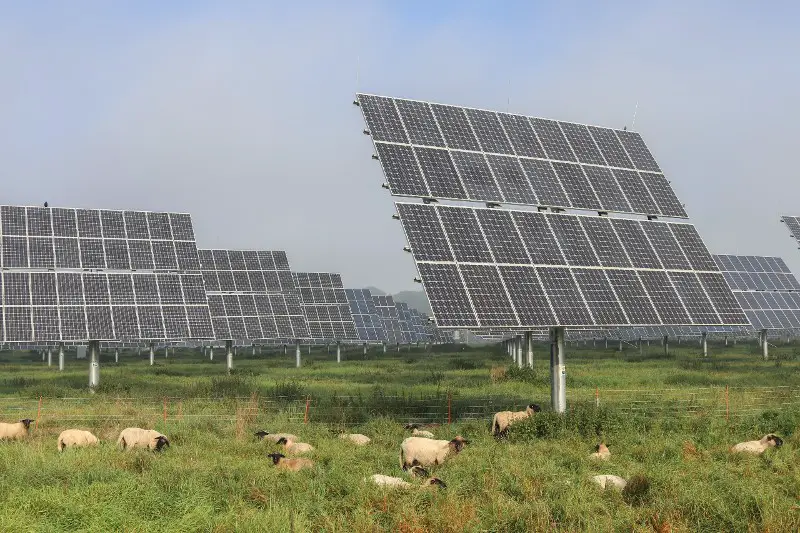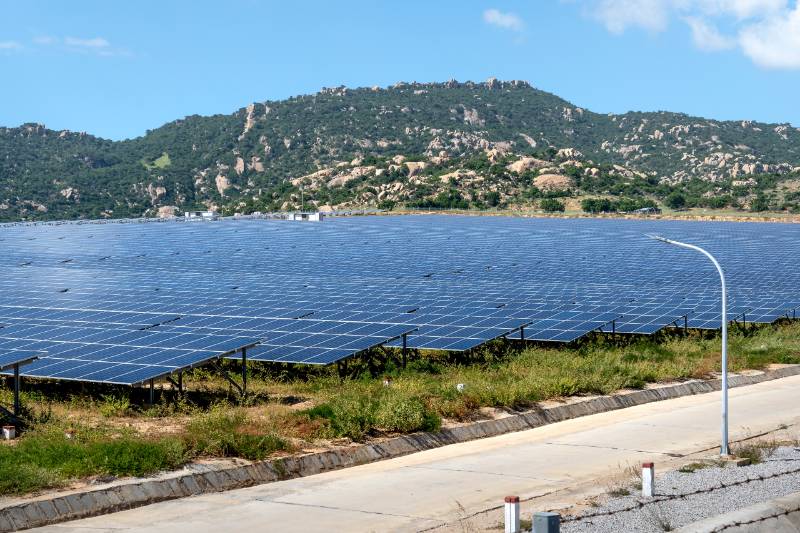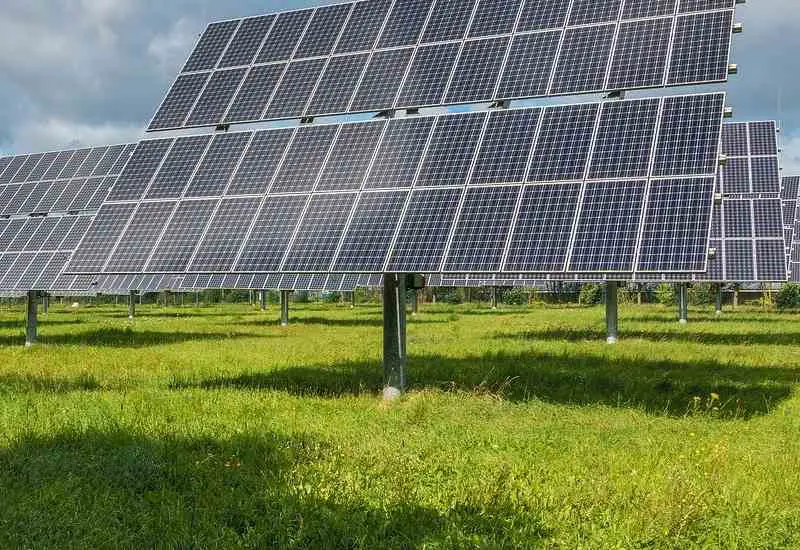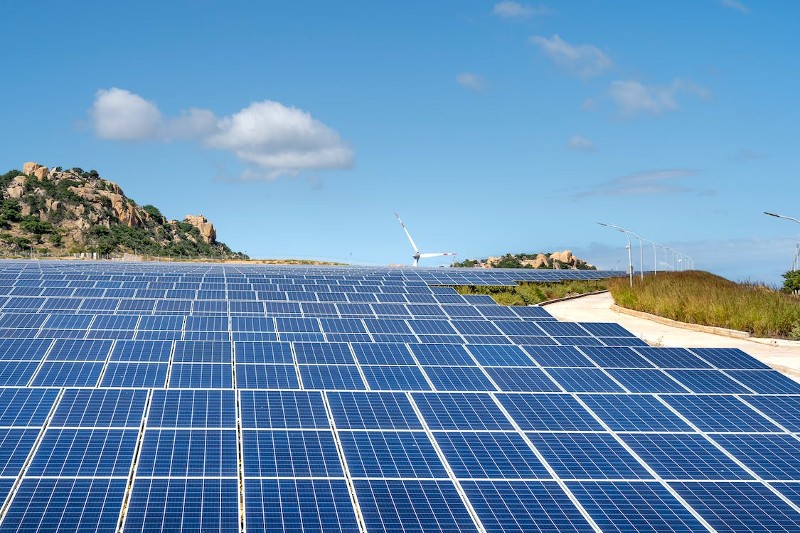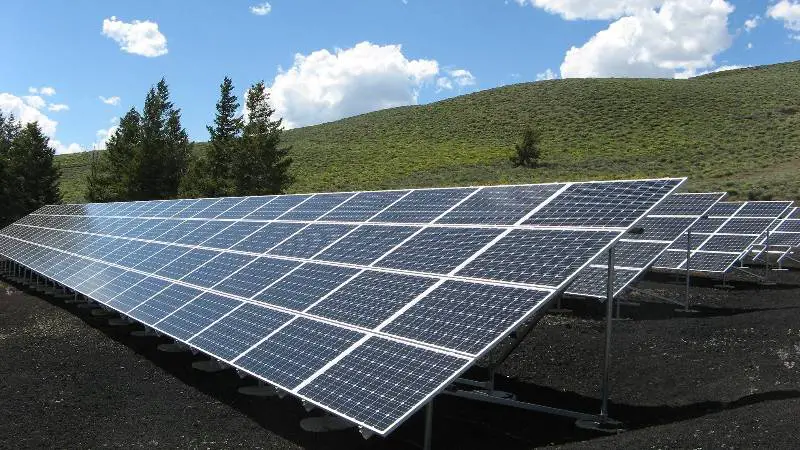A 1 acre of solar panels makes about $28,000 a year in the United States.
However, this is just a ballbark estimation. Your earnings can differ depending on things like where you are, how much sun hits your panels, and what electricity costs in your area.
In this article, I’ll guide you through how these factors can change what you earn from a solar farm.
We’ll look at how to make the most out of your investment and get a good grip on the financial landscape that affects solar profits.
Key Takeaways
- One acre of solar panels makes about $28,000 annually on average.
- You can fit about 1,452 solar panels on one acre, but the actual capacity is closer to 200 kilowatts due to space for equipment.
- A 1-acre solar farm in California with 5.31 peak sun hours per day can produce around 333,680 kWh per year.
- Factors affecting profits include sunlight exposure, panel maintenance, land size, lease rates, proximity to power lines, soil quality, electricity rates, REC rates, and incentives.
- Building a 1-acre solar farm costs between $170,000 and $215,000, depending on installation costs and other variables.
How Much Money Does 1 Acre of Solar Panels Make Annually?
One acre of solar panels makes annually about $28,000 on average.
The money you can make from an acre of solar panels depends on where you set up and how well your solar farm runs.
Let’s break it down: typically, an acre of solar panels can churn out about 337.5 megawatt-hours (MWh) of electricity annually.
Now, if we take the going rate for wholesale electricity, which is about $83 for each MWh, you’d usually be looking at making around $28,000 a year from that one acre.
But keep in mind, that’s just an average.
Depending on how much sun your area gets and the price of electricity there, your actual yearly earnings could swing anywhere between $21,250 and $42,500.
How Many Solar Panels Can I Fit in One Acre?
You can fit about 1,452 solar panels on one acre if each uses up around 30 square feet.
This includes the space needed not just for the panels themselves, but also for mounting them and for maintenance.
This number comes from the size of an acre, which is 43,560 square feet.
Now, you might think, “Great, I can just fill that space with panels and produce a ton of energy, right?”
Well, it’s not quite that simple.
Although the math suggests you could theoretically generate 435.6 kilowatts with 300W panels, there’s more to setting up a solar farm than just laying down panels.
You also need space for important gear like inverters and electrical distribution units.
These are essential for converting solar energy into electricity that’s usable and for managing how that electricity gets distributed.
Because of this, the actual amount of power you can effectively set up and maintain is closer to 200 kilowatts per acre.
How Much Power Will 1 Acre of Solar Panels Produce?
To determine how much power 1 acre of solar panels will produce, you need to understand a bit about peak sun hours.
These are the hours of the day when sunlight intensity averages about 1,000 watts per square meter.
For instance, if a place gets 4 peak sun hours a day, it receives 4,000 watts per square meter daily.
Now, let’s say you’re setting up a 200 kW solar farm in California, where the sun shines for about 5.31 peak sun hours each day.
That totals around 1,940 peak sun hours over a year.
To calculate the total power output, use this formula:
Power Output (kWh) = Solar Plant Size (kW) x Number of Peak Sun Hours (h) x 0.86
The 0.86 multiplier accounts for typical losses due to factors like heat, shading, and debris—common issues that can reduce the efficiency of solar panels.
So, applying these numbers, you get:
Power Output = 200 kW × 1940 h × 0.86 = 333,68 kWh/year
This means your 1-acre solar farm would produce about 333,68 kWh per year, which equates to roughly 333.68 MWh/year.
What Are the Factors That Affect the Profits From a 1-Acre Solar Farm?
1. Sunlight Exposure
Sunlight exposure is crucial when it comes to the success of a solar farm.
Here’s an easy way to think about it: solar panels are like big sponges that soak up sunlight.
The more sunlight they get, the more electricity they can generate.
Let’s look at Phoenix, Arizona, as an example.
Phoenix is famous for its sunny climate, getting about 299 sunny days each year.
That’s a lot of sunlight for solar panels to absorb, making it an ideal spot for a solar farm.
More sunlight means the panels can generate a lot of electricity, which translates to higher profits from selling that electricity.
On the other hand, consider Seattle, Washington, which is known for its cloudy weather.
With fewer sunny days, a solar farm in Seattle won’t capture as much sunlight as one in Phoenix.
This means it’ll generate less electricity and, consequently, less profit.
2. Solar System Conditions
Keeping your solar panels in good condition is super important for their performance.
Think of it like taking care of a car—it needs regular upkeep to run well.
Solar panels work best when they’re clean and free of dirt, dust, and debris.
If they get dirty, they can lose up to 25% of their efficiency, which means less electricity.
For example, if your solar farm is supposed to generate $10,000 worth of electricity a year, dirty panels could cost you $2,500 in lost revenue.
That’s a big chunk of change!
Regular cleaning and maintenance can help you avoid this loss and keep your panels working efficiently.
3. Size of Land Used
When setting up a solar farm, the amount of land you have is pretty key.
More land? More space for solar panels.
And more panels mean you can generate more electricity, which can lead to higher profits.
But, there’s a catch—more land isn’t just more space; it also means higher costs right from the start, whether you’re buying or leasing.
So, here’s the deal: You’ve got to weigh the cost of the land against the money you’ll make from the power the panels produce.
It’s all about using your space wisely to get the most bang for your buck.
4. Land Lease Rate
The cost of leasing land for your solar farm can vary depending on your location.
Let’s break it down: if you’re out in rural Iowa, the lease might only set you back about $500 per acre each year.
However, if you’re closer to a big city in California, that cost can skyrocket to as much as $4,000 per acre every year.
This huge difference in leasing costs can affect your bottom line.
Let’s assume that your 1-acre solar farm pulls in $20,000 a year.
In California, where the lease costs are high, 20% of your revenue could go just to cover the lease.
But back in Iowa, the lease would only eat up about 2.5% of your earnings.
5. Proximity to Distribution Lines
How close your solar farm is to the nearest power lines can impact your setup costs.
The closer you are, the cheaper it’ll be to connect to the grid.
Let’s say your solar farm is only a mile away from the nearest three-phase power line.
In that case, hooking up might cost you between $15,000 and $25,000.
But if your farm is 5 miles out, that cost can skyrocket to over $100,000 because you’ll need more infrastructure to make the connection.
6. Soil Quality
Soil quality might not be the first thing on your mind when you think about setting up a solar farm, but trust me, it’s pretty crucial.
Good soil can help your solar panels perform better.
First off, you need firm, stable soil to properly install the panels.
If the soil is too soft or shaky, you might end up shelling out extra cash for special foundations or more intensive ground prep.
This bumps up your initial costs right off the bat.
But that’s not all.
Poor soil can lead to issues like erosion or shifting, which can damage your equipment over time.
This means you could be facing higher maintenance costs and lower efficiency from your solar farm.
Not ideal, right?
To avoid these problems, it’s smart to test the soil before you settle on a site for your solar farm.
This step can help you steer clear of unexpected expenses and make sure your panels are set up on a solid foundation.
7. Wholesale Electricity Rate
The amount you can earn from the electricity your solar farm generates can differ depending on where you are.
This all comes down to something called the wholesale electricity rate, which plays a big role in how much money you can make.
Let’s break it down with an example.
In Texas, the wholesale rate might be around 4 cents per kilowatt-hour (kWh).
But over in New York, it could be a bit higher, like 7.3 cents per kWh.
Now, say your 1-acre solar farm pumps out 250,000 kWh each year.
At Texas rates, you’d be looking at making $10,000 annually.
But in New York, with the higher rate, you’d make about $18,250 a year.
8. RECs Rates
Renewable Energy Certificates (RECs) are a cool way to earn some extra cash from your solar farm.
The price you can get for RECs varies a lot depending on where you are, and this difference can boost your profits.
Here’s how it works: In some places, you might be able to sell RECs for about $10 each.
But in other areas, they could go for as much as $50 each.
Let’s say your solar farm generates enough electricity to earn 500 RECs in a year.
In a state where RECs are priced at $10, you’d make an extra $5,000.
But if you’re in a state where RECs go for $50 each, you could rake in an additional $25,000!
9. Incentives
Incentives can help cut down your initial costs when setting up a solar farm.
They come in various forms like tax credits, rebates, and grants.
Each of these can make a big difference in how much you end up spending.
Take the Federal Investment Tax Credit (ITC), for instance.
This handy tax credit lets you knock off 30% of your installation costs from your federal taxes.
So, if you’re spending $100,000 on your solar setup, you can shave $30,000 off your tax bill.
And it doesn’t stop there.
Some states throw in extra incentives.
For example, California runs the Self-Generation Incentive Program (SGIP), which offers rebates if you install energy storage systems.
These additional state incentives can further drop your costs and boost your return on investment.
What Is the ROI on the Solar Farm?
The ROI (Return on Investment) on a solar farm isn’t just a straightforward number.
ROI depends on a few things like how much you spend to set it up, the ongoing costs of running it, and how much cash you make from selling the electricity it produces.
The Solar Energy Industries Association says that on average, it takes about 7.5 years for a utility-scale solar project in the US to start paying for itself.
Tax rules in the U.S. also play a big role in how profitable your solar farm can be.
Here’s a quick rundown on how taxes affect different types of solar setups:
- Residential Solar Panels: If you install solar panels at home for your use, you can get a federal tax credit for 30% of what the system costs. This sweet deal is good whether you buy or lease the panels, and there’s no cap on how much you can claim.
- Commercial Solar Farms: If you own a solar farm and sell the power you generate, you’ll have to pay federal income tax on that money. But, you can lighten your tax load thanks to perks like a 30% Investment Tax Credit (ITC) and the chance to speed up depreciation.
- Community Solar Projects: These are usually owned by a bunch of people together, or by someone who develops the project and then sells the electricity to local utilities. They get the same tax breaks as commercial solar farms.
- Off-Grid Solar Systems: If you set up solar panels in a remote spot where there’s no grid to connect to, you can still benefit from tax incentives like the ITC and accelerated depreciation. Just remember, you can’t sell any extra electricity since you’re not hooked up to the grid.
How Much Does a 1-Acre Solar Farm Cost?
One acre solar farm costs between $170,000 and $215,000 to build.
Let’s break this down a bit: the pros at the Solar Energy Industries Association (SEIA) tell us that it costs about $0.85 to $1.07 for each watt of capacity you install.
Since you can fit about 200kW of solar panels on an acre, these costs add up to give you the total price tag for getting your solar farm up and running.
Of course, this is just a ballpark figure.
Your actual costs can vary based on factors like the specific location, the type of panels you choose, and the installation company you hire.
So, it’s a good idea to get a few quotes and nail down your budget before diving in.
How Much Can You Make Leasing Your Land for Solar Farms?
You can earn anywhere from $250 to $3,000 per acre each year by leasing your land to solar farms.
However, how much you make can vary a lot.
It depends on a bunch of things like how much sun hits your land, what the soil’s like, how close you are to power lines, and what land goes for in your area.
So, if you’re thinking about leasing out your land, you’ll want to consider all these factors.
FAQs
How Much Does a 1MW Solar Farm Cost UK?
A 1MW solar farm in the UK typically costs around £1 million to build, based on industry averages.
How Many Acres of Solar Panels to Power the US?
To power the entire US with solar panels, about 14 million acres of land would be needed at 13-14% efficiency, which is roughly 22,000 square miles.
How Many Solar Panels Does It Take to Make One Megawatt?
It takes about 3,333 solar panels, each with a capacity of 300 watts, to generate one megawatt of power.
How Many Solar Panels to Power a House?
On average, it takes about 16-25 solar panels to power a typical house, depending on energy usage and panel efficiency.
Conclusion
As promised, we’ve broken down the main things that can affect how much money you can pocket from an acre of solar panels.
It all comes down to how sunny your spot is, the going rates for electricity in your area, and the kind of regulations you need to follow.
If you’re thinking about getting into the solar farm game, here’s a pro tip: start by really checking out your potential site.
How much sun does it catch? What are the electricity prices like around there?
Don’t forget to also look into any state or federal incentives that might help with the costs and boost your profits.
Got any questions? Drop them in the comments below—I’m here to help!
Join our solar microdosing newsletter and get bite-sized, easy-to-understand insights into the world of solar energy.
From how solar panels work to building your own DIY solar system, we’ve got you covered.


